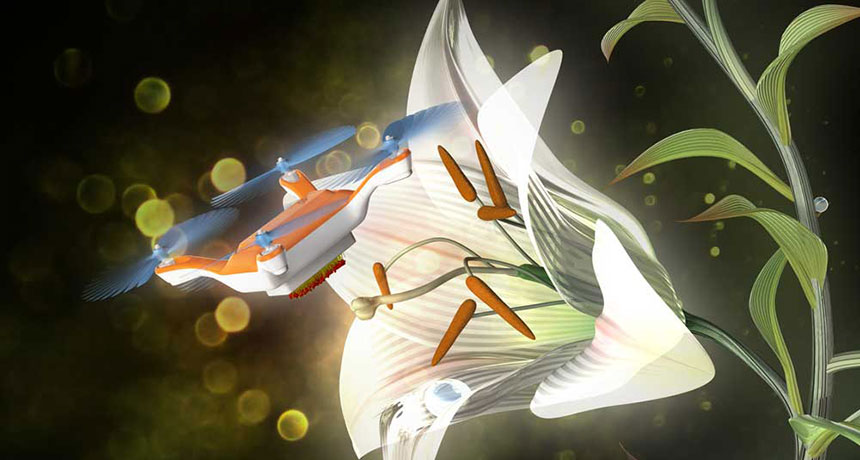Fleets of drones could pollinate future crops

Eijiro Miyako gets emotional about the decline of honeybees.
“We need pollination,” he says. “If that system is collapsed, it’s terrible.”
Insects, especially bees, help pollinate both food crops and wild plants. But pollinators are declining worldwide due to habitat loss, disease and exposure to pesticides, among other factors (SN: 1/23/16, p. 16).
Miyako, a chemist at the National Institute of Advanced Industrial Science and Technology in Tsukuba, Japan, became passionate about the loss of pollinators after watching a TV documentary. He remembers thinking: “I need to create something to solve this problem.”
His answer was in an 8-year-old jar in his lab.
In 2007, he had tried to make a gel that conducts electricity, but it was “a complete failure,” he says. So he poured the liquid into a jar, put it in a drawer and forgot about it. Cleaning out his lab in 2015, he accidentally dropped and broke the jar.
Surprisingly, the gel was still sticky and picked up dust from the floor. Miyako realized that the gel’s ability to capture the tiny particles was similar to how honeybee body hairs trap pollen. His thoughts jumped to artificial pollination.
First, he investigated whether non-pollinating insects could help do the job. He dabbed his gel onto ants and set them loose in a box of tulips. The ants were coated with pollen after three days.
Still, Miyako worried that predators would snack on his insect pollinators. To give them camouflage, he mixed four light-reactive compounds into the gel. He tested the new concoction on flies, placing a droplet on their backs and setting the insects in front of blue paper. Under ultraviolet light, the gel changed from clear to blue, mimicking the color of the backdrop.
Though this chemical invisibility cloak might protect the insects, Miyako wanted a pollinator that could be controlled and wouldn’t wander off at the first scent of a picnic.
He bought 10 kiwi-sized drones and taught himself to fly them, breaking all but one in the process. Miyako covered the bottom of the surviving drone with short horsehair, using electricity to make the hair stand up. Adding his gel made the horsehair work like bee fuzz.
In tests so far, the drone has successfully pollinated Japanese lilies more than a third of the time, brushing up against one flower to collect pollen, then flying into another to knock the grains off, his team reports in the Feb. 9 Chem.
Glad he saved that failed gel, Miyako thinks it is possible to automate a fleet of 100 drones, using GPS and artificial intelligence, to pollinate alongside bees and other insects. “It’s not science fiction,” he says.